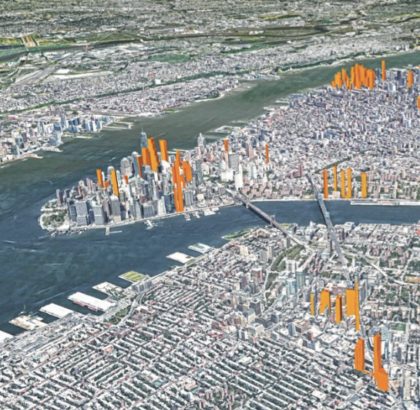In the News: City of Shadow
••• New York magazine has an item about how interior design firm Roman and Williams—they did Gwyneth Paltrow’s old Tribeca apartment—is opening “its first store, with a florist, an art-supplies room, and a shoppable library,” in December. The location isn’t mentioned, so I dug around and found a Vogue article that says it’ll be called Roman and Williams Guild NY “after the historic department store that originally occupied the Howard Street location.”
••• “Moving trucks and boxes were spotted on Friday outside Harvey Weinstein’s former office in Tribeca. A staffer told Page Six: ‘Everyone from 375 Greenwich St. went to 99 Hudson St. We always had two offices, and now it’s being moved into one building . . . 375 is where Harvey was.'” —New York Post
••• A profile of Tribeca artist Toni Dove on the occasion of “a survey exhibition, Toni Dove: Embodied Machines, Feb. 25 to May 20 at the John and Mable Ringling Museum of Art in Sarasota, Fla. The show will be the largest gathering of Ms. Dove’s work.” —New York Times
••• “On Tuesday, the City Council is set to repeal the city’s Cabaret Law, a Prohibition-era rule that made it illegal to dance in most nightspots.” —New York Times
••• “Statement of Battery Park City Authority Chairman Dennis Mehiel on the passing of former Chairman James F. Gill. James Gill served as Battery Park City Authority Chairman from 1996-2010.” —Broadsheet
••• A New York Times article on Bouley at Home, chef David Bouley’s new Flatiron project, includes this: “He still is an owner of Brushstroke, the Japanese restaurant on Hudson Street, and is sole owner of Bouley Botanical, an event space nearby. But he’s at least two years away from opening another Bouley, this time an intimate 25-seater on Harrison Street.”
••• “The Municipal Art Society […] is sounding the alarm about the increasing proliferation of ‘super-tall’ skyscrapers. […] In a new report, ‘The Accidental Skyline—2017,’ the MAS notes that while there are currently six ‘super-tall’ buildings in Lower Manhattan, there are another 13 currently either under construction or in the planning stages. MAS cites a spectrum of worries associated with such buildings, including the need to protect public assets like light, air, open space, and the character of the city’s neighborhoods, as well as the prospect that local civic infrastructure (in the form of schools, transportation systems, healthcare resources, water and sewage networks, and trash collection services) may be overwhelmed by the large populations that such buildings draw, whether they are residential or commercial.” —Broadsheet
















Aren’t they just a tad late on sending out an alarm about all these crazy tall buildings? Bloomberg stayed too long at the party.